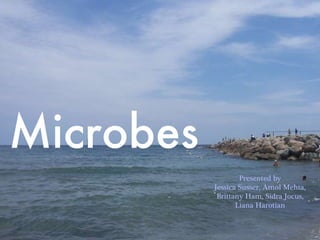
Microbe presentation
- 1. Microbes Presented by Jessica Susser, Amol Mehta, Brittany Ham, Sidra Jocus, Liana Harotian
- 2. A microbe is defined as any microscopic organism (otherwise known as microorganisms) What are microbes? Examples: Bacteria, Archaea, Viruses, small parasites
- 3. Important microbes of the deep: BACTERIA
- 5. Where are Bacteria found in the oceans? Everywhere! All throughout the ocean, in every water column. Some live independently, while others form symbiotic relationships with other organisms.
- 6. Cyanobacteria (blue-green algae) Photosynthetic Greek: “kyanós” meaning blue Fossils as old as 3.5 mya Found in extreme environments (high salinity areas, deep sea vents, etc)
- 7. Cyanobacteria: Continued They account for ~ 25% of Earth’s photosynthetic production Their electronic activity is an important pathway for conversion of solar energy into chemical energy They can include unicellular or colonial species
- 8. Cyanobacteria and Ocean Acidification Genus Trichodesmium increased photosynthetic rates under elevated CO 2 conditions Bloom-forming Nodularia decreased cellular division rates under elevated CO 2 conditions Possible explanation for difference: Different ecological strategy of the two bacteria
- 11. Symbiotic Relationships Many nitrogen-fixing bacteria have symbiotic relationships with diatoms (unicellular, photosynthesizing organisms), and these bacteria contribute significantly to global nitrogen fixation Some nitrogen-fixing Cyanobacteria live in coral-reefs and have symbiotic relationships with the coral. Nitrogen fixing and nitrifying bacteria also live in sponges. Symbiotic bacteria inside microscopic life forms called diatoms take nitrogen from the air, enabling them to thrive in the nutrient-poor tropical Atlantic Ocean. Credit: David Caron US National Science Foundation
- 13. ARCHAEA Genetically and biochemically different from bacteria Methane producers Very small; usually less than one micron long (1/1000 of a meter) Discovered in 1970’s by Dr. Carl Woese and his colleagues at the University of Illinois while studying relationships among prokaryotes
- 15. Archaea Environment: Extreme living conditions Hydrothermal vents in deep ocean (methanogens, sulfate reducers, and extreme thermophiles) Hot springs (methanogens, sulfate reducers, and extreme thermophiles) Highly saline land-locked seas (halophiles) Extremely alkaline or acid waters Anoxic muds in marshes or at the bottom of the ocean (methanogens) Deep underground petroleum deposits
- 16. However... New research shows that archaeans do not only live in extreme environments, but are also abundant in plankton in the open sea, as well as coral in coastal marine environments
- 17. Example of Archaea: Halobacterium They live in extremely saline waters They contain pigment (bacteriorhodopsin) that gives the archaea its color and provides it with chemical energy (similar to a pigment found in our retinae)
- 18. Effects of ocean acidification: Archaea might actually benefit from ocean acidification because they can survive in highly acidic water However, those archaeans which are found in plankton and coral may be negatively affected by the decline of plankton and coral populations due to acidification
